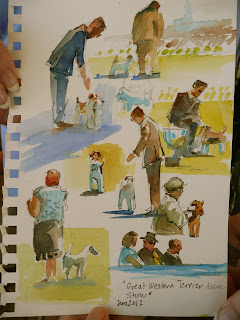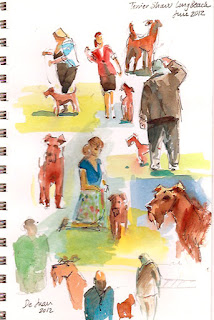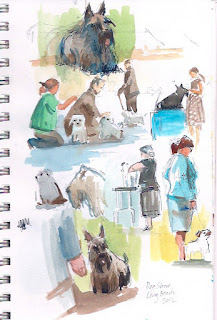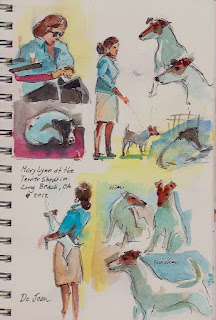 |
| "Vertical Country" 48"x 60" oil on canvas |
27 June 2012
Joshua Been's book
Painter Joshua been, who I had the pleasure of meeting in San Luis Obispo (CA) and Telluride (CO) a couple of times has written a small but condensed book about Painting, mostly about painting in plein air. Joshua is a very talented painter and I did receive my copy of his book yesterday. I am grateful Joshua wrote this little book and think I might use it as a primer if I ever , or rather, when I teach a workshop again. I think it was generous of him because Joshua really tried to condense most of his experience and techniques in a way that was accessible and detailed.
I do not obtain any benefit whatsoever from advertising Been's book but I think people might find it answers quite a few questions regarding painting and at the very least it reveals the methods of working artist.
Dog Show
A friend of mine is a big dog (smooth terrier) lover and aficionado. She invited me to a Dog Show in Long Beach. I am always for visiting harbors and I figured I could paint the Queen Mary or the beautiful forest of cranes and harbor machinery. Once I got there I was immediately drawn to the quirky ambiance and specially to the dogs. So with the Queen Mary behind me looking massive but uninteresting I set up to sketch the dog show instead.
Here are my sketches of the "Wire Terrier" breed segment. A lady bought the sketch off my notebook for 30$. (hey, parking and a new notebook right?). I think it was the most succesful page and it garnered me the most comments and "likes" on facebook I've ever had . Who knew?
A especial page dedicated to my friend Mary Lynn and her dogs Mimi and Cracker. I gave the page to her even though I don't like tearing them. After all, she made the invitation and I am glad I shwed up. Sometimes immersing oneself in an environment one knows nothing about (race horses, the military, factories ..I can think of a million) is a great source of inspiration.
Here are my sketches of the "Wire Terrier" breed segment. A lady bought the sketch off my notebook for 30$. (hey, parking and a new notebook right?). I think it was the most succesful page and it garnered me the most comments and "likes" on facebook I've ever had . Who knew?
 |
| The Smooth terrier, Wire Terrier segment |
So I continued sketching away and making lots of new friends in the process. I sketched the irish terriers (along with their handlers and judges). I also jumped around and trying to capture gesture and shape with a maximum economy of gesture and trying to make the pages look interesting by themselves. No lack of models for sure.
 |
| Irish Terriers. |
 |
| Scotties and other breeds. |
A especial page dedicated to my friend Mary Lynn and her dogs Mimi and Cracker. I gave the page to her even though I don't like tearing them. After all, she made the invitation and I am glad I shwed up. Sometimes immersing oneself in an environment one knows nothing about (race horses, the military, factories ..I can think of a million) is a great source of inspiration.
 |
| Mary Lynn and her smooth terriers and friend. |
16 June 2012
Edgar Payne show at PMCA
I rushed today in 15 minutes through the magnificent show of Edgar Payne , The Scenic Journey at the Pasadena Museum of California Art. It is unfortunate photographing was not allowed. The show was divided by thematic matter: The Sierra Nevada of California occupies the largest surface followed closely by boat paintings from France and Italy. I thing Edgar Payne might have enjoyed the Sierra Nevada more than the boats which I feel he saw more of a compositional challenge even though they are superbly rendered as well. Other subjects encompass California scenes from Laguna (mostly of crashing waves), the Foothills of the San Gabriel Mountains (sycamores, eucalyptus and such) to the The Navajo country (big vertical rock walls and nomadic natives) and the Southwest and European landmarks (boats, castles and the Alps).
A few things jump immediately at the viewer. First, the size. These are large paintings. As a matter of fact, one must take a six or seven steps away to see some of them start to come together. Especially mountain scenes. I haven't seen many contemporary painters that require that much distance to congeal.. One can almost feel the weight of impressionism on the painters of this period. The second thing that jumps at you is the thick, deliberate and BIG brushstrokes, not a lot of finely wedged strokes and carvings, just big bold strokes and an interesting but effective "weave" of colors. Payne uses brushstrokes of clean color juxtaposed with others equally clean strokes of thick impasto. The sum becomes the final color....at a distance. Payne must have had a large studio to practice this pointillist technique.
There is a third item that soon becomes apparent, his compositions are very correct but a bit similar. He wrote a great book called "Composition of Outdoor Painting" in 1941 so he was very deliberate in his choices but one wonders if he felt bound by the same grammar he taught in all his pieces. There are very few awkward croppings or what I hesitate to call "modern" framing of scenes and they seem to be limited to the boat scenes. The mountains scenes are by the book and so are most other of the sublime landscapes.
If you go to the exhibition, one should not miss the drawings, photographs and compositional studies he made. they are superb, secure and one can see the seed of every large canvas in them. It's pretty amazing he was two years younger than Picasso. I throw that in there for perspective.
Undoubtedly, Edgar Payne is a "painter's painter", bold, fast and with a keen sense of color and balance. He seems to have "played it safe" a bit but the result is astounding and the brush work would contradict that very statement.
I specially loved one of the paintings of the Matterhorn at sunset. The picture I add here doesn't do it justice at all but you know the drill ...no photos. However, there is a beautifully illustrated catalog for sale I would buy if I had any space left at all in my apartment.
 |
| "Breton Tuna boats, Concarneau, France" 1924 |
There is a third item that soon becomes apparent, his compositions are very correct but a bit similar. He wrote a great book called "Composition of Outdoor Painting" in 1941 so he was very deliberate in his choices but one wonders if he felt bound by the same grammar he taught in all his pieces. There are very few awkward croppings or what I hesitate to call "modern" framing of scenes and they seem to be limited to the boat scenes. The mountains scenes are by the book and so are most other of the sublime landscapes.
If you go to the exhibition, one should not miss the drawings, photographs and compositional studies he made. they are superb, secure and one can see the seed of every large canvas in them. It's pretty amazing he was two years younger than Picasso. I throw that in there for perspective.
 | |
| "Hills of Altadena 1917-1919 |
Undoubtedly, Edgar Payne is a "painter's painter", bold, fast and with a keen sense of color and balance. He seems to have "played it safe" a bit but the result is astounding and the brush work would contradict that very statement.
I specially loved one of the paintings of the Matterhorn at sunset. The picture I add here doesn't do it justice at all but you know the drill ...no photos. However, there is a beautifully illustrated catalog for sale I would buy if I had any space left at all in my apartment.
Subscribe to:
Comments (Atom)
